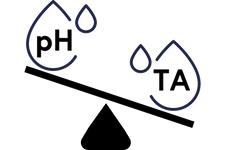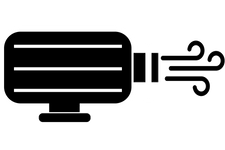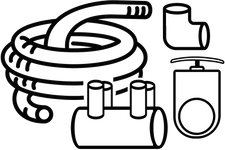How-To Guides | Hot Tub Air Blower Replacement
Electrical wiring and repairs can be dangerous, especially around water, and must be performed by a qualified electrician or spa technician. Shut off electrical power to the hot tub or pool at the service panel prior to any inspections or work. Disclaimer
Also called air pumps or bubblers, blowers push air into the spa through small ports or jets. This creates bubbles not unlike those in a glass of champagne. Although water pumps create strong pressure for the best massage, many enjoy the tingling feeling added by a blower.

In-Cabinet Portable Spa Air Blowers
In portable spas, most air blowers are inside the cabinet, protected from rain and moisture. These smaller units are installed below the water line, so they require careful plumbing to avoid water damage.
About Air Plumbing in Hot Tubs
Water is aerated differently depending on the spa. One type of plumbing involves a channel attached to the shell with holes allowing air to bubble into the water.
The most common method in modern hot tubs connects the blower to a PVC manifold. The air goes through smaller air lines to individual air injector jets.
Repair or Replace?
Old style air blowers consisted of a household vacuum cleaner motor in rubber housing. The air intake was in the top with the output at the bottom end. This type of blower fails easily because the motor was never designed for a damp environment. It is also common for pests to enter the intake pipe, damaging the fan.
If the blower fails, don't just replace the motor. An entire assembly usually costs the same or less than a new blower motor. With less work and a new warranty, you'll get a lot more mileage out of a new one.
A modern, high quality, spa air blower will have a drive motor designed to hold up well in damp conditions. It will run quieter than a vacuum cleaner motor, and have a hose-less filtered air intake for cleaner output air.

Choosing the Correct Replacement
Check the label on the existing blower for horsepower and voltage ratings. Choosing the wrong horsepower or voltage rating can result in a serious malfunction. If your spa’s main power is wired 240V, your blower may be either a 240V or 120V. Of course, spas wired for 120V require 120V blowers.
Avoiding Water Intrusion
The most common cause of blower failure is moisture inside the housing. If not plumbed properly, water can back up into the housing and damage the motor. Even condensation can short out electrical parts.
Keep water out of the blower by looping plumbing above the water line inside the cabinet (called a Hartford Loop). Since the plumbing is above the water line, an air pocket forms at the highest point, preventing most water spillover.
Check Valve
In addition to the Hartford Loop, a one-way check valve offers added protection against water getting into the blower. Like a subway turnstile, the valve opens allowing air through, and closes with the air off, so water cannot pass.
Install a new check valve at the time the blower is replaced. Since check valves contain small parts that eventually fail, this inexpensive part is a cheap insurance policy against water intrusion.

Our replacement 1/4 lb. rated check valves are universal and accept either 1.5" slip fittings or 2" spigot connection.
In-Cabinet Blower Installation
For weather-protected blowers inside the spa cabinet, follow these simple removal and replacement instructions.
You will need:
- Easy-Air Spa Blower
- Check Valve
- Screwdriver
- Set screws or clamps

Removal
Open the hot tub's equipment access door and locate the old blower assembly.
- Turn the power off to the spa at the breaker
- Disconnect the air duct hose from the blower's exhaust port
- Unplug the blower's electrical cable from the spa control pack
- Disconnect grounding wire, if present
- Remove mounting screws and blower
Install
- Verify power to the spa is off at the breaker
- Replace check valve prior to blower installation
- Re-mount blower with screws from old blower
- Use set screw or clamp to reattach plumbing to check valve
- Plug blower into spa pack
- Restore power to the blower and check for proper function
Blower Mounting
If space and plumbing considerations allow, mount the blower as high as possible with the exhaust opening pointing downward. This is one more precaution against moisture entry from the hot tub.
Plumbing Connections
When installing the new check valve, never glue any connections on the dry side. Flex PVC tubing, self-tapping set screws and clamps prevent the need for glued fittings.

Everything between the blower and the check valve is considered the dry side. The portion between the check valve and the spa is the wet side. PVC cement is used on the wet side to prevent water leaks, but tiny air leaks are not a consideration.
Hazard: PVC cement emits highly flammable fumes which can cause combustion or an explosion from the operation of a blower. If there are any glued connections to the air blower system, allow ample time for the cement to dry. Allow all fumes to completely dissipate before attaching the hose to the blower (with screws), before turning-on the blower.
The Spa Depot assumes no liability for the use nor makes any warranty as to the accuracy, electrical code or building code compliance, suitability or usefulness of the information provided herein. This information is not intended to replace or substitute for information contained in equipment owner’s manuals. You expressly agree to hold The Spa Depot and its employees harmless for any property damage, personal injury and/or death, or any other loss or damage that may result from your use of the information provided. No advice or information, whether oral or written, obtained by you from this web site or our employees shall create any warranty not expressly made herein. Reader agrees to assume all risk resulting from the application of any of the information provided herein. By using this web site, including any content contained therein, the visitor agrees that the use of this web site and its information product is entirely at his/her own risk. Consult with a licensed electrician, qualified spa technician, and/or licensed contractors as appropriate.
Read Electrical Caution Statement
"The new blower assembly was compact and easy to install, and ended up costing less than just a replacement motor! It even runs quieter than the old one. Your tech support department was first-rate, more than helpful with my repair questions."
Mort Sorenson
Fair Oaks, CA





























